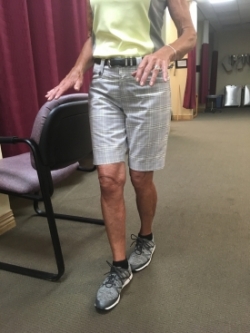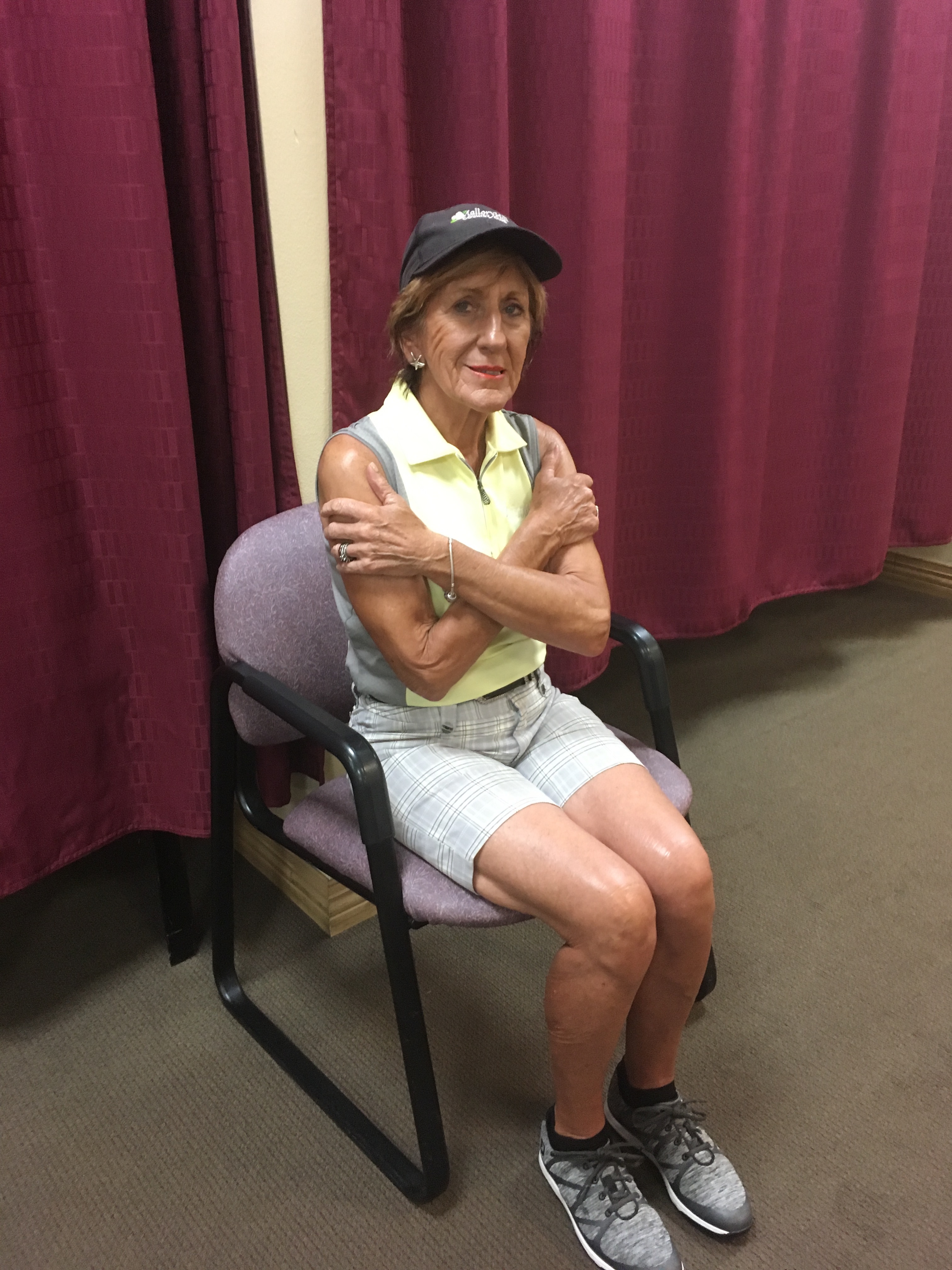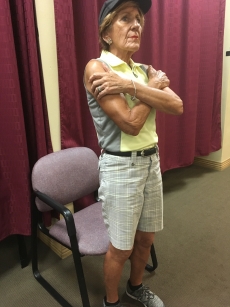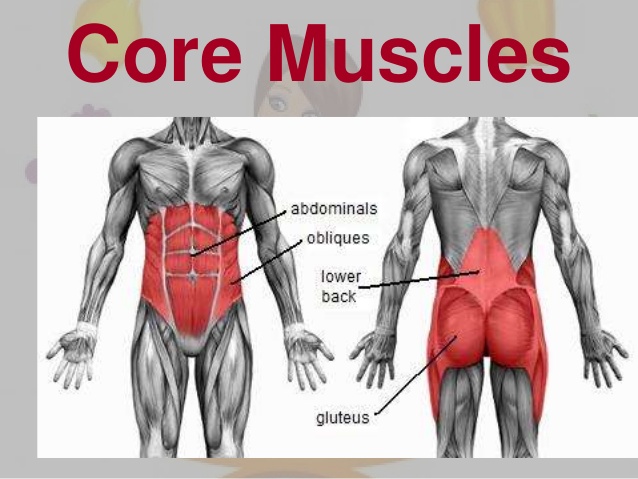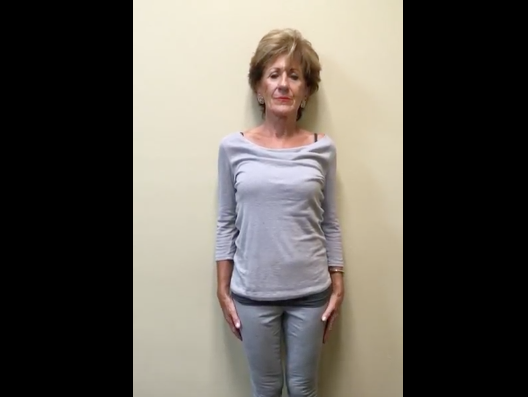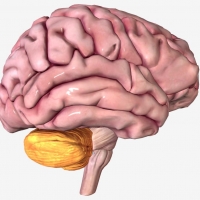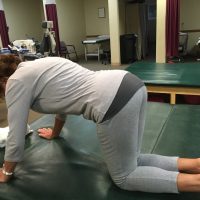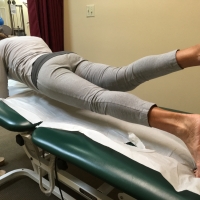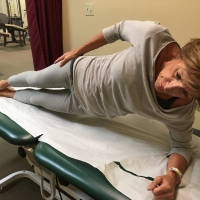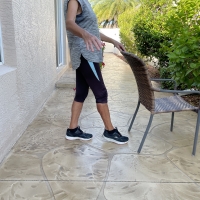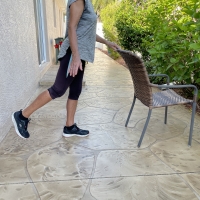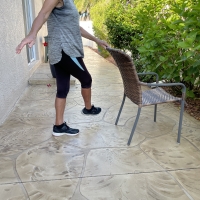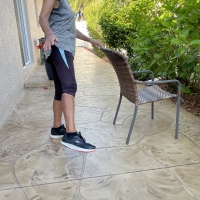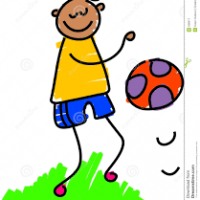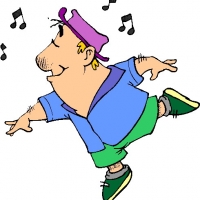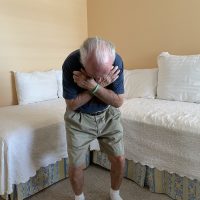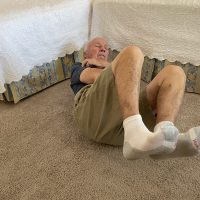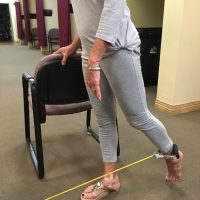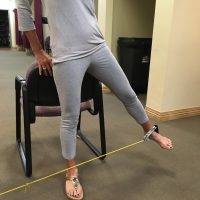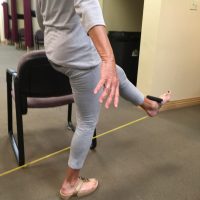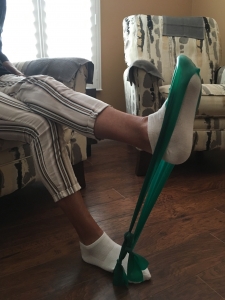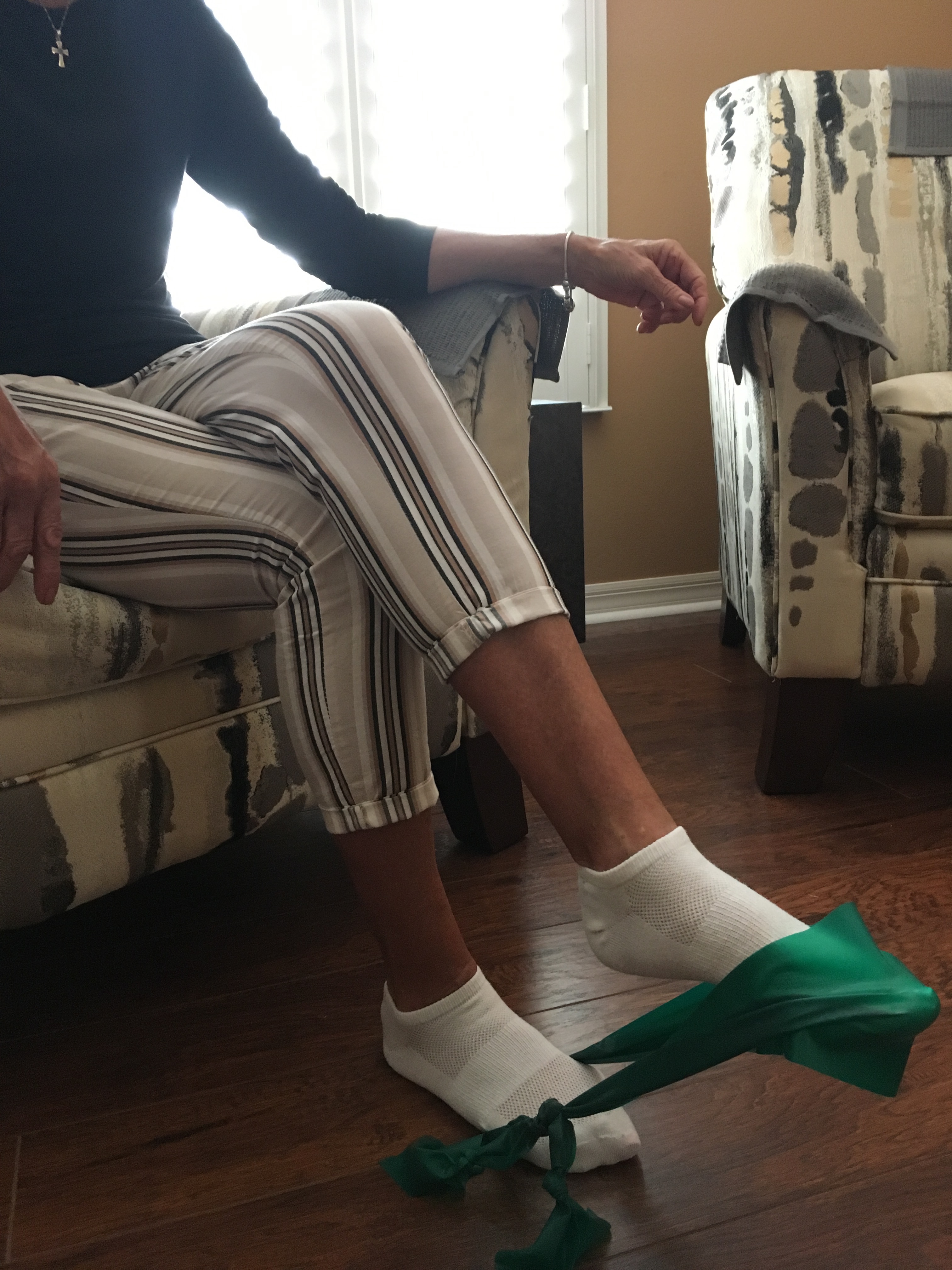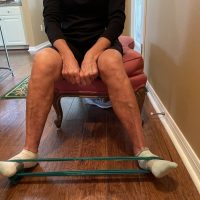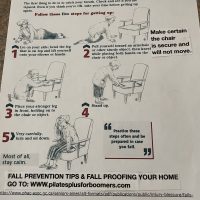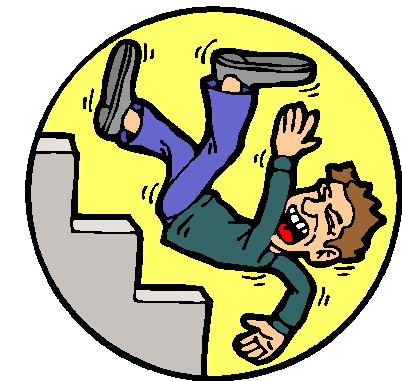Have you fallen lately?? . Falls are becoming an epidemic with individuals over 65 years.
Every 19 minutes someone dies from a fall.
Every 11 seconds a person arrives at an emergency room because of a fall .
20 -30% of indivuals falling never get back to previous activities.
One out of 4 persons over age of 65 will suffer a fall this year. Risk of a fall increases every year after age 65.
BALANCE IMPROVEMENT EXERCISE PROGRAM…………..
“SIT LESS..MOVE MORE” “Activate the Cerebellum:Improve Balance & Reduce Falls Utilizing Pilates Concepts/Techniques”.
We have all heard that for good health we need to engage in moderate physical activity like brisk walking, at least 150 minutes a week. More physical activity helps reduce high blood pressure, decreasing the risk of death from heart disease or stroke, reduces falls, relieves depression and anxiety and boosts memory and concentration.
Why is it as we age falls increase?? Because we sit MORE and move LESS. On average americans spend half of their waking hours in sedentary behavior, sitting at work, school and home, while driving, in restaurants, watching tv or working on our computers/phones. WE don’t fall because we are old. WE fall because we cease doing balancing exercises.
A resent article in Bottom Line Health , Sara K Rosenkranz, PhD associate professor in the Dept. of Kinesiology & Nutrition Sciences at the school of Integrated Health Studies, Univ. of Nevada and Emily Mailey, PhD, Associate professor in the Dept. of Kinesiology, and director of the Physical Activity Intervention Reaseach lab at Kansas State University revealed in a recent survey of nearly 6000 people conducted by the Center of Disease Control & Prevention, 25% said they spent more than 8-10 hrs a day sitting. Many retired individuals sit 12-14 hours a day.
Sitting hurts your health for several reasons. when you are sedentary and expending low levels of energy for a long period of time, your body essentially shuts down its metabolic machinery. You generate fewer enzymes that stimulate the metabolism of fats for fuel. The heart pumps less blood. Your breathing becomes shallower. The muscles in your legs and buttocks– which burn most of your calories- burn far fewer.
Excessive sitting can also make you sick. It puts you at a higher risk of high blood pressure, heart disease, stroke, type 2 diabetes, and several cancers(breast, colon, endometrial and ovarian). Sitting is also linked to increased depression. Recent research shows that simply standing up deceases several of the risks from sedentary behavior.
If you sit a lot, your goal might be to stand up and do your sitting activity standing. do some quick standing stretches or take short walks outdoors, ex: 10 minute walks 3 times a day to get you moving toward better health. Take some time and do strengthening exercises with therapeutic tubing.. go to a gym 2-3 times a week, enroll in healthy classes, Yoga, Tai Chi or dance classes. Work on Better Balance activities . If you are in your retirements years or close to it change your life to a healthier one, you never know you may be an influence on others to try a healthier life.
SIT LESS….MOVE MORE… You may be amazed how much better you feel
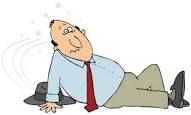 Edward Yuiska, PT, Retired Sports Physical Therapist conducts the program.
Edward Yuiska, PT, Retired Sports Physical Therapist conducts the program.
Weekly Exercise Class held @ LaHacienda Rec. Center on Mondays @10:00 am to 11:00 am
“ Learn to improve balance, strengthen your body and improve your lifestyle utilizing Pilates core stabilization/proper posture. Learn how Better Balance activities can become part of your daily activities.
Learn how to fall and get back up. Also, strengthening hip and ankle musculature utilizing therapeutic theraband.
A tree needs a strong trunk or core, to survive “bad weather”.So does the body need a strong core to survive “bad weather”.Pilates believed that in order to achieve happiness, it was imperative to master your own body.
No flip flops, participants need one small ball (tennis ball size) plus therapeutic theraband.
To reduce falls… SIT LESS and MOVE MORE!!!
Along with:
1. Maintaining Pilates (proper) posture throughout the day.
2. Consistently stimulating the Cerebellum which controls walking, posture, balance, coordination, motor learning.
3. Increase strength of core and lower extremity musculature.
Test your risk of a fall.
Evidence shows as individuals age their balance diminishes, depending on their activity level.Practicing balance activities daily while maintaining lower extremity strength reduces the risk of falls. Practice 3-5 better balance activities for 3-5 minutes each. Alternating better balance activities daily.
Maintain Pilates Posture stand erect, by elongating the spine, keep the head on the shoulders, not the chest. pull belly button upwards to the spine pulling pelvis up and level) Think of the pelvis as a bucket, keeping it level. Breathe out maintaining the level pelvis.
1. Single leg stance 30 Seconds
Stand on one leg , other leg not touching static leg. Hold the position, maintaining the posture. No body swaying, etc. When toe touches other leg or floor time ends. Alternative method: stand on one leg for 30 seconds. Record each time one needs to touch chair to regain balance.
As the number of touching to regain decreases , it is an indication balance is improving.
IF unable to maintain minimum 15 seconds, it indicates increased risk of falling evident.
Try balancing 5 sec. touch chair to regain balance then repeat balancing 5 sec again and repeat balancing 5 times.
After 5 days doing this method increase balance time to 10 seconds then regain balance by touching chair with 2 fingers, repeat 5 times.
After five days increase balancing to 15 seconds and repeat with rebalancing with two fingers on chair, repeat 5 times.
After 5 days increase balancing to 20 seconds 5 times with rebalancing , repeat balancing 5 times.
After 5 days . Test the balance for 30 seconds one time. Refer to age group and test balance according to age group. Continue testing 2-3 times weekly for 30 sec with goal of balancing at least the seconds of age group.
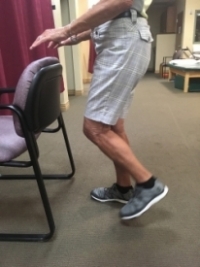
Age: 50 – 59 60 – 69 70 -79 80 – 89 90 – 94
Sex M – F M – F M – F M – F M – F
Seconds 41 40 33 30 25 23 15 10 10 6
2. One Foot in front heel/toe touching Test
Brace chair against wall. Place one foot in front with heel and toe touching
GOAL: Maintain balance for 30 seconds. Repeat with opposite foot. Keep track of number of touches. As the number decreases , it is an indication balance is improving.
3. Sit to Stand Test 30 Seconds
Brace chair against wall. Sit in middle of chair with feet flat and arms crossed.On “go” rise to full stand then return to seat continue for 30 seconds Scoring: Number of total full stands.
Age 60-64 65-69 70-74 75-79 80- 84 85-89 90-94
Sex M – F M – F M – F M – F M – F M – F M – F
Reps 23 21 23 19 21 19 21 19 19 18 17 16 16 16
Excellent exercise for strengthening trunk and lower extremities by doing on a daily basis until able to match the reps above.
Improving Balance W/ Pilates Core Stabilization
Control the Core!!! The keystone to a better lifestyle.
The concept of lengthening and strengthening muscles was initiated by Joseph Pilates, who died in 1967. He based this technique on extremely sound principles. He devised his unique conditioning program after looking at various forms of yoga,ballet and martial arts. The method lengthens muscles while strengthening them, stabilizing the lumbar spine and pelvis along with controlled breathing, facilitates deep abdominal contraction. All energy for the Pilates exercises flows outward to the extremities.
The core muscles are a large group of muscles in our center, encompassing the abdomen, lower back, hips and buttocks. These muscles stabilize the spine,pelvis and shoulders and provide a solid foundation for movement in the extremities. These muscles help control movements,transfer energy, shift body weight and move in any direction.
A strong core distributes the stresses of weight bearing and protects the back. .
Stabilize the Core Muscles
Abdominals get all the credit for protecting the back and being the foundation of strength, but they are only a small part of what makes up the core. In fact, it is weak 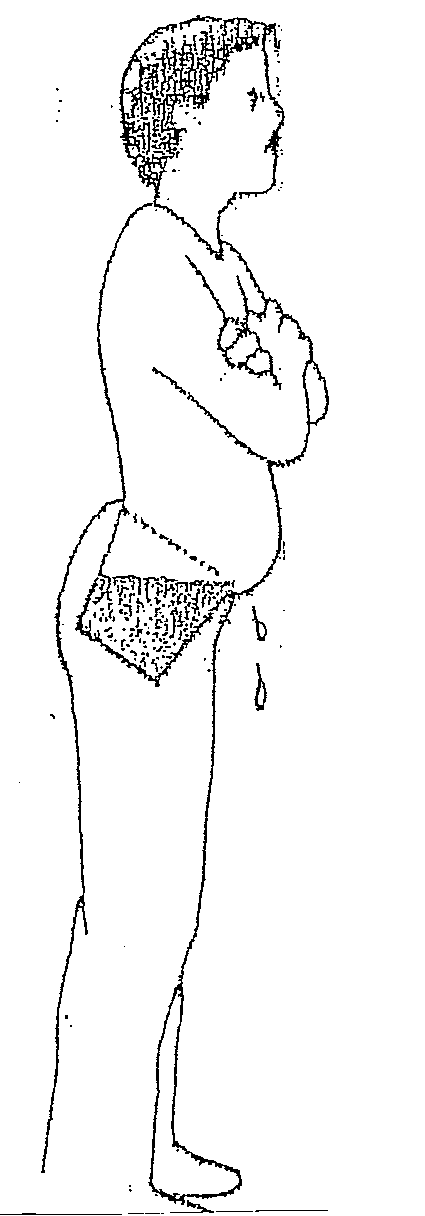 and unbalanced core muscles that are linked to low back pain. Weak core muscles result in a loss of the appropriate lumbar curve and a swayback posture. Stronger, balanced core muscles help maintain appropriate posture and reduce strain on the spine.
and unbalanced core muscles that are linked to low back pain. Weak core muscles result in a loss of the appropriate lumbar curve and a swayback posture. Stronger, balanced core muscles help maintain appropriate posture and reduce strain on the spine.
Core Muscles Improve Balance
Because the muscles of the trunk and torso stabilize the spine from the pelvis to the neck and shoulders, they allow the transfer of powerful movements of the arms and legs. All powerful movement originates from the center of the body out, not from the limbs alone. Before any powerful rapid muscle contractions can occur in the limbs, the spine must be solid and stable and the more stable the core, the more powerful the extremities can connect.
Training the muscles of the core also corrects postural imbalances that can lead to 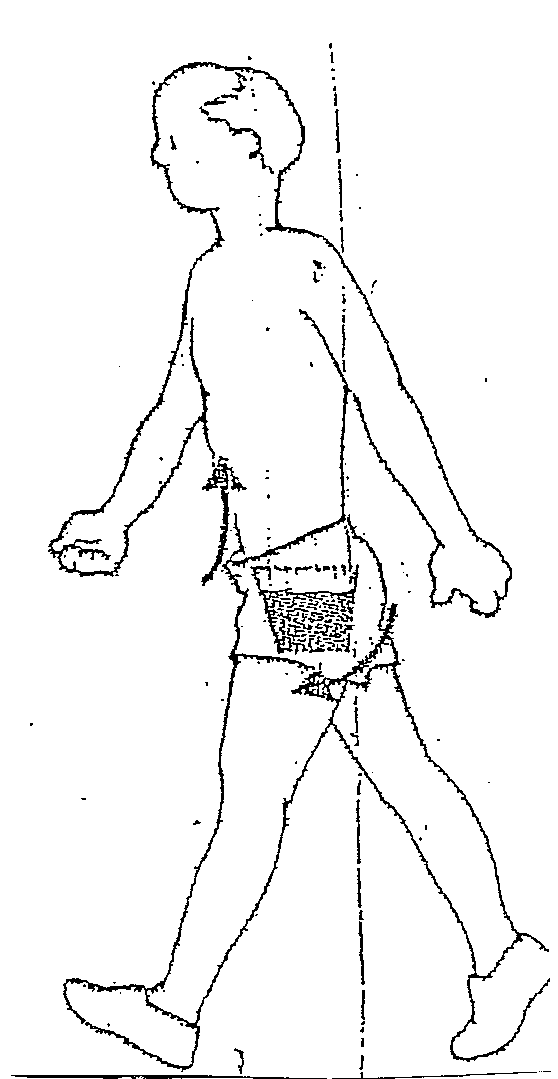 injuries. The biggest benefit of core training is to develop functional fitness – that is fitness that is essential to both daily living and regular activities.To facilitate an active core contraction:
injuries. The biggest benefit of core training is to develop functional fitness – that is fitness that is essential to both daily living and regular activities.To facilitate an active core contraction:
CONTROL YOUR CORE….The Keystone to a Better Lifestyle!!!!
To initiate core stabilization:
Sitting in a chair: 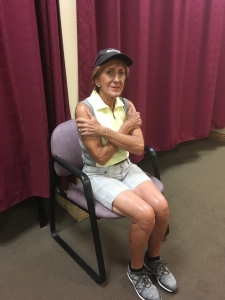
Push the low back against the back of the chair.
Inhale to prepare. Blow out and pull the belly button up and back, pushing the back against the chair, (think of pelvis as a bucket, getting it level) elongate the spine ,pull head back on shoulders and sit up straight. Inhale to relax and repeat.
Standing up:
2. Stand up straight keep the head on the shoulders, not the chest.
3. Blow out forcefully, like blowing out a candle at the same time pull the pubic bone to the ribs and drive the belly button inward towards the spine, pause and breath in slowly.
4. Repeat every 5 seconds
5..Visualize your pelvis is a bucket of water, pull up on the bucket and keep it level.
6..Repeat through out the day with daily activities including recreational.
7. As the core muscles become stronger less effort is required to “keep your bucket level”
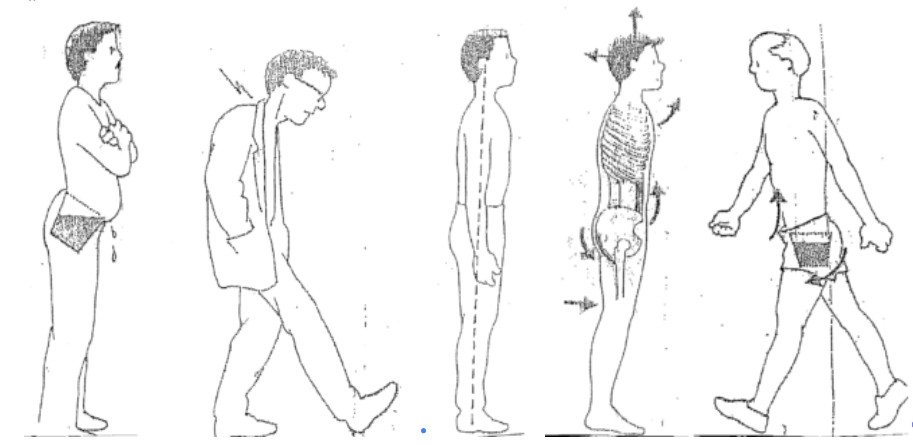 Check your posture with low back, mid back and head against the wall, elbows bent arms to shoulder level.
Check your posture with low back, mid back and head against the wall, elbows bent arms to shoulder level.
What is the cerebellum?
The portion of the brain in the back of the head between the cerebrum and the brain stem. The cerebellum controls balance for walking and standing, and other complex motor functions.
The cerebellum (“little brain”) is a structure that is located at the back of the brain, underlying the occipital and temporal lobes of the cerebral cortex …
The cerebellum controls voluntary movements such as:
The major functions of the cerebellum are its involvement in balance (controlled via its connection to the inner ear), equilibrium, muscle tone, coordination, and motor learning: Control of balance and posture. The cerebellum is responsible for making adjustments to posture in order to maintain balance.Nov 26, 2019
How does cerebellum control movement?
Maintaining balance: The cerebellum has special sensors that detect shifts in balance and movement. It sends signals for the body to adjust and move. Coordinating movement: Most body movements require the coordination of multiple muscle groups.
Do you remember when you learned to ride a bike? The cerebellum is responsible for you learning to ride a bike. Without a cerebellum, it would be impossible to learn how to ride a bike, play the piano, or perform a gymnastics routine or play pickelball. It is involved in how the brain learns muscle movement and how it hones those movements for improvement. As a ballet student develops into a ballerina or a piano novice grows into a professional pianist, they have their cerebellum to thank for its ability to fine-tune action and controlled movement.
Maintenance of balance and posture. The cerebellum is important for making postural adjustments in order to maintain balance. Through its input from vestibular receptors and proprioceptors, it modulates commands to motor neurons to compensate for shifts in body position or changes in load upon muscles. Patients with cerebellar damage suffer from balance disorders, and they often develop stereotyped postural strategies to compensate for this problem (e.g., a wide-based stance).
info on Cerebellum taken from Google & Patricia Facty staff “Facty Health”
What is the Better Balance System?
It is a series of important exercise activities designed to give you the tools to practice fall prevention in the comfort of your own home and at your pace. By routinely performing the Better Balance System you will benefit: Complete 5 activities daily for 5 minutes each or 5 reps. Start at Level 1 and progress to next level when able to complete the activity without mistakes for one week. Incorporate the activities in conjunction with your routine activities such as: After brushing your teeth; while waiting for your coffee to brew: taking computer break: in the evening when ads come on tv. Vary the activities daily throughout the week. THIS ADDS up to 20-25 minutes of activity PLUS you are sitting less…moving more
1. Exercising In Bed Improves: 
Flexibility and mobility by warming your muscles and ligaments
Better physical fitness overall.
Increased ability to walk safely.
Increased mental and physical relaxation.
Reduced tightening of muscles and leg cramps.
Reduced soreness of muscles.
Reduced chances of injuring joints, muscles or tendons.
EXERCISES LYING DOWN IN BED, HOLD STRETCH 30 seconds.
- STRETCH arms out overhead/legs straight out and raise few inches.Do hand flexion/extension/ ankle dorsi/plantar flexion, circles 5 reps each direction.
- STRETCH: bend both knees with feet flat on bed. Rock legs to side with knees touching bed left/right.
- Hold 5 seconds ,while breathing out and pulling the belly towards the spine Repeat 5 reps.
- STRETCH: Stretch arms out to the side at right angle. Take left foot and rotate your trunk and touch the foot to the bed, use arms to stretch the leg to the bed and try to touch the right hand,
- while breathing out and pulling stomach to the spine, hold 5 sec than complete with right foot to the left hand. Repeat each side 5 reps.
- After one month alternate above exercises with the 4 exercises below.
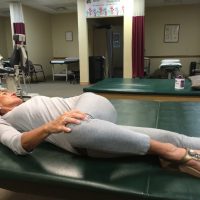
Cross left leg over right leg with left knee flexed. Apply pressure with right hand on knee to feel stretch in left hip.
Hold 30 seconds. Repeat with opposite leg. Complete 3 reps
Prone on hands/knees for DOG/CAT STRETCH. Breathing out / push belly button towards spine and elevate back( like a cat getting ready to attack). Hold 5 seconds.
Breathing in and drop pelvis down create sway back. Hold 10 seconds. Repeat 5 reps. Avoid increased pain in low back.
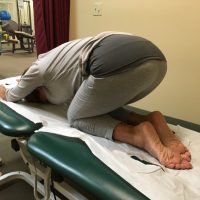
Prone on hands/knees. Bend forward/ extending the arms. Sit back on heels stretching arms out straight. Hold for 30 seconds.
Breathing in and out every 5 seconds, tightening core muscles when breathing out. Complete 5 reps.
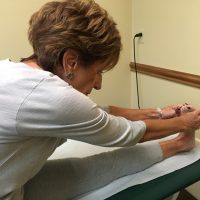 Hamstring Stretch: hang right leg over edge of bed. Extend left leg reaching forward grasp foot with both hands. Try to get left leg flat on bed. If unable still stretch for 30 seconds. Repeat with right leg by turning around and dropping left leg over edge of bed . Repeat 3 times
Hamstring Stretch: hang right leg over edge of bed. Extend left leg reaching forward grasp foot with both hands. Try to get left leg flat on bed. If unable still stretch for 30 seconds. Repeat with right leg by turning around and dropping left leg over edge of bed . Repeat 3 times
Core Strengthening Exercises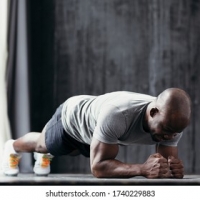
Begin in the plank position with forearms toes on the table/floor. Keep torso straight and rigid, body in a straight line from ears to toes, no sagging or bending. head relaxed. Pull the belly button to your spine as you breathe in & out. Hold this position 10 sec Repeat 5 reps. Every week increase 5 sec until doing 30 sec with 5 reps Do this 3-4 times weekly. Add variations of the regular Plank. Plank with alternating leg lift. PlankW/ alternating arm lift holding 5 seconds doing 5 reps.
Begin in the plank position with forearms toes on the table/floor. Keep torso straight and rigid, body in a straight line from ears to toes, no sagging or bending. head relaxed
Pull the belly button to your spine as you breathe out Raise one leg. Hold this position for 10 seconds. Alternate legs . Repeat 5 reps. Every week increase 5 sec until doing 30 sec with 5 reps. Do this 3-4 times weekly.
Lie on side, shoulder over elbow, and toes on table/floor lift both legs up. Keep torso straight and rigid, body in a straight line from ears to toes, no sagging or bending with head relaxed. Pull the belly button to your spine as you breathe in & out. Hold this position 10 sec. Repeat 1 rep. Every week increase 5 sec, until doing 30 sec repeating 1 rep.
2.Balance Exercises (Refer to article”Make New Balance Exercises a Part of Your Daily Activities)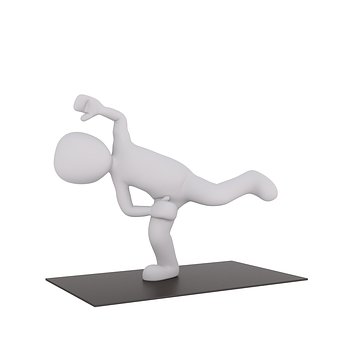
Achieve better posture, increase leg strength, improve confidence and stabilize your body through a series of Balance Activities.
Keeping one’s balance is a complex process.
It involves the use of many of the body’s mental and physical attributes.
To balance safely, one must rely on a constant flow of information to and from the brain about how the body is positioned.
Always have a chair or counter close by in case you lose your balance. Always wear shoes.
Level 1 face chair or counter. One or two fingers touching the chair. touch the toes forward on the ground or floor. Touch the toes backward on the ground or floor. Touch toes across the body on floor or ground. Touch toes out to the side of the body Bring foot to resting foot. Repeat with other foot. Alternate 5 times. If able to complete the 4 different exercise movements 5 times one week in a row without balance loss progress to next level.
Level 2 Same as level one DO NOT TOUCH THE CHAIR, Count the number of times one touches the chair. Repeat 5 reps When able to complete one week without balance loss go to level 3
Level 3 Same as level 1 touching chair . Point toe to the floor. Do not touch the floor. Complete all 4 positions.Repeat with other foot. Alternate 5 times. If able to complete the 4 different exercise movements 5 times for one week in a row without balance loss progress to next level.
Level 4 Same as level 3 , do not touch the chair.Repeat with other foot. Alternate 5 times. If able to complete the 4 different exercise movements 5 times for one week in a row without balance loss progress to next level. If able to complete the 4 different exercise movements 5 times one week in a row without balance loss stay at this level.
3.Ball Handling Activities
Discover your body’s natural ability to balance, think, and move at the same time by performing easy, energizing Ball Handling Activities.
Helps to develop many skills:
Endurance
Coordination
Agility
Lateral Balance
Spatial Awareness
Kinesthetic Awareness
Eye/Hand Coordination
Gross motor coordination
Visual Motor Coordination
EXERCISES: Follow the ball with your eyes. Maintain Pilates posture. Repeat 12 reps.
Go to next level when able to complete the activity one week without mistakes.
- WEEK ONE/SITTING: Tossing the ball back/forth. REPEAT 12 times,
- WEEK ONE/SITTING: One hand overhead/other at waist. Drop ball to waist hand. REPEAT 12 times ATERNATING HANDS,
- WEEK TWO STANDING: Repeat # 2 standing in place
- WEEK THREE STANDING: Walk forward/backward with normal step stride . Repeat # 3. for 5 steps Alternate feet
- WEEK FOUR STEP SIDEWAYS TO LEFT & RIGHT 5 reps each direction 5 times WITHOUT BOUNCING BALL , maintaining proper posture. STANDING IN FRONT OF COUNTER or TABLE HOLDING ON one hand… 5 reps each direction
- WEEK FIVE STEP SIDEWAYS TO LEFT & RIGHT 5 reps each direction 5 times WITHOUT BOUNCING BALL , maintaining proper posture. STANDING IN FRONT OF COUNTER or TABLE WITHOUT HOLDING ON one hand… 5 reps each direction
- WEEK SIX STEP SIDEWAYS TO LEFT/RIGHT CROSSING LEFT FOOT IN FRONT/BACK OF RIGHT LEG : REPEAT WITH RIGHT LEG FRONT/BACK OF LEFT LEG : STANDING IN FRONT OF TABLE OR COUNTER, WITHOUT BOUNCING BALL 5 reps each direction 5 times. HOLDING ON WITH ONE HAND…….
- WEEK SEVEN STEP SIDEWAYS TO LEFT/RIGHT CROSSING LEFT FOOT IN FRONT/BACK OF RIGHT LEG : REPEAT WITH RIGHT LEG FRONT/BACK OF LEFT LEG : STANDING IN FRONT OF TABLE OR COUNTER, WITHOUT BOUNCING BALL 5 reps each direction 5 times. WITHOUT HOLDING…….
4. Walking While Talking on the Phone or without phone. 
The objective of this exercise activity is to practice “dual tasking”, performing two activities at the same time “walking”and “talking”.STANDING BEHIND CHAIR/COUNTER Go to next level when able to complete the activity one week/ 5 phone calls or 5 pretend phone calls without mistakes.
- STANDING: Assume heel-toe stance Hold 30 sec standing. Change feet. Repeat 5 reps When able to complete FIVE DAYS/ PHONE CALLS without balance loss go to next level.
- STANDING: Repeat level 1 without holding on for 30 SEC Change feet. Repeat 5 reps . When able to complete FIVE DAYS without balance loss go to next level.
- STANDING: Walk forward-back 5 steps with normal step holding on.. Repeat 5 times When able to complete one week without balance loss go to next level.
- STANDING: Walk forward-back 5 steps with normal step without holding on.. Repeat 5 times When able to complete one week without balance loss go to next level.
- STANDING: Assume heel-toe stance Walk forward/back 5 steps holding on Repeat 5 reps. When able to compete without balance loss 5 days go to next level.
- STANDING Repeat # 5 without holding on. When able to complete 5 days without balance loss. Continue 3 times /weekly
5. TIGHT ROPE WALKING USING FLOOR BOARDS/TILE.
. Find the lines on the tile floor or wooden floor. . Stand next to a counter or table . Proceed to level 1.
 Level 1 Stand beside table or counter with feet between lines of the tile or wooden floor hold on to table/chair walking normal 5 steps forward & backwards staying between the lines. Repeat 5 times. When able to complete the walking staying between the lines for one week advance to level 2.
Level 1 Stand beside table or counter with feet between lines of the tile or wooden floor hold on to table/chair walking normal 5 steps forward & backwards staying between the lines. Repeat 5 times. When able to complete the walking staying between the lines for one week advance to level 2.
Level 2. Repeat level 1 without holding on to the table or counter, etc. Repeat 5 reps staying between the lines forward & backwards. When able to complete the activity one week without losing balance proceed to level 3
Level 3. Repeat level 1 walking on one line(BOARD) instead of between the lines holding on. Repeat 5 reps Continue with level 3 until able to complete activity one week go to .
Level 4. Repeat level 2 walking on one line (BOARD) instead of between the lines without holding on. Repeat 5 reps. Continue to do level 5 2-3 times weekly.
Level 5 Assume heal/toe position Walking on one line 5 steps forward/back holding on. When able to complete 5 reps for 5 days go to Level 6
Level 6 Complete level 5 without holding on. When able to complete 5 reps forward/back for 5 days continue to do 3 days a week.
6. Dancing with a Pillow.
With a soft pillow as a dance partner, learn to move freely and improve your balance by doing waltz steps or walk around in a circle.
-
- LEVEL 1 Step forward with your left foot ..then step forward with the right foot..
- Close your left foot to your right foot. …
- Step back with your right foot.turning to the right. (pick up the right foot, then the left foot, do not drag the feet when turning…
- Repeat with your left.foot …
- Close your right foot to your left foot. Turning until you are back to the position where you started.
- If able to complete the complete circle 5 times without mistakes for one week go to Level 2
- LEVEL 2 Start with the right foot instead of left foot turning to the left. . Turning until you are back to the position where you started.
- When able to complete the circle 5 reps for one week without mistakes go to Level 3
- LEVEL 3 Continue to alternate starting feet. Completing the turns to the right & left 5 times each. Do 3 days weekly.
The Art of Falling (AVOID IF FEARFUL OF FALLING)

 Reduce your fear of falling and avoid or limit injury from a fall by practicing the “Art of Falling”. Teaching your body and cerebellum to relax is important in reducing falls. Do this 2-3 nights when watching TV, during one advertisements.
Reduce your fear of falling and avoid or limit injury from a fall by practicing the “Art of Falling”. Teaching your body and cerebellum to relax is important in reducing falls. Do this 2-3 nights when watching TV, during one advertisements.
if you have history of back problems or surgery place several pillows on the chair before doing the slumping. If pain develops when doing the slump, avoid doing the slumping. People who have practiced slumping don’t resist when they fall. They are training their proprioceptive sense, which is one’s ability to sense their bone joint position and joint motion.
#1 RULE OF FALLING DOWN: RELAX:
DON’T: Try to stop the fall , especially if you are older.
GOAL: spread the impact over as much of your body as possible, such as your butt, thighs, and upper back to soften the fall
The Backward Fall: Go limp. Tuck your chin to your chest, try to get your body(especially your butt) closer to the ground. Bend your knees into a deep squat, so you land on your butt, then round your spine and roll unto your back & shoulders. Keep your arms across the chest, out of harm’s way.
DON’T: fall on the bony part of your hip, which is how hip fractures occur.
DON’T: plant your arm down when landing, could break your shoulder, ellbow, wrist.
DON’T: look up or extend your neck which will guarantee that your head hits the ground first.
DON’T: stick your arms out behind you to catch yourself may result in broken wrist.
DON’T go stiff and stick your arms straight in front of you. Falling onto an outstretched hand most cause of wrist fracture.
PLEASE DON’T GET RIGHT UP: Assess any cuts,bumps, & possible breaks to reduce the risk of further injury
Strengthening Lower Extremities w/ Therapeutic Tubing
Many balance problems can become worse with leg strength and active motion deficits. Utilizing therapeutic tubing to reduce the weakness is an excellent method to use with easy application.
Attach one end of tubing to table leg or object that will not move. Place chair next to you to hold on to for balance. Stand erect and maintain Pilates posture, move leg in 3 different directions. Each time you move the leg against resistance breathe out and pull the belly button to the spine, breathing out for 5 seconds and breathe in 5 seconds when relaxing taking the leg back to original position.
Repeat 12 reps each of the directions. As you get stronger replace the tubing with heavier resistance or move further away from the attachment for increased resistance.
To improve balance hold lightly to the chair or release hand occasionally.
Strengthening Lower Extremities with Theraband
Place theraband around ankles. D0 a partial squat, keep the pelvis level. Step sideways and back. Step forward laterally, step backwards laterally, return to starting position. Repeat each direction 10 – 15 reps. Hold onto a chair or center/table.
Strengthening Ankle/knee Musculature w/Theraband
Place theraband over toes/hold with other foot. Straighten knee/pull toes towards knee.
Hold 5-10 seconds. Repeat 10-15 reps. Repeat with other foot.
Place theraband around toes. Raise toes up off the floor.
Make a fist and place both hands at inside of the knees. Push knees against hands. Push theraband out ward.
Tighten abdominals breathing out 5 seconds, relax and breathe in 5 seconds. Repeat 12 reps.
“I’ve Fallen!” Ways to Getting off the Floor.
View video from www.homeability.com
Many people experience a fall and find themselves uncomfortably trapped on the floor for hours or in some cases days, unable to get up. If you find yourself in this unfortunate predicament, there are a number of things you can do to help increase the chance of either getting yourself off the floor or alerting others you need help.
View video: Click on “I’ve Fallen”. Click How to get up from the floor MacGyver style
Getting off the floor
Many times people experience a fall which does not result in any injuries, but then find they are unable to get from the floor. If you do find yourself in such a situation, it is helpful to be aware of ways to rescue yourself if there is nobody around to help. Two fall recovery strategies are described below.
Basic Fall Recovery Technique: If you are able to do so, roll yourself over onto your stomach, ease yourself up onto your hands and knees, and then try to crawl to the nearest chair, couch, or your bed. We’ll use a “chair” as an example here. Begin by kneeling in front of the chair. Place both hands (or elbows if need be) on the seat. Then, bend the knee of your strongest leg, drawing it upwards, followed by placing your foot flat on the floor. Next, push down through your arms on the seat while using your bent leg to give you leverage to aid in standing up. The basic fall-recovery technique can be viewed in this video.
MacGyver-Style Techniques: If you are unable to get up using the standard fall recovery technique, then it is time to turn on your MacGyver-style thinking and find a way to use the things around you to aid you in getting up from the floor. See Video:
Get Someone’s Attention
If you sustain a serious injury during the fall, your emphasis should not be on getting up on your feet because you could worsen the injury. Instead, your focus should be on getting someone’s attention to come help.
Below are some steps you can take to try to alert others you need help.
If you cannot access a phone to call for help, do your best to scoot yourself closer to a door or window where people are more likely to hear you call out for help. You can try using the Glute Scoot or Inch Worm technique shown at the end of the video ” to move yourself closer to a door or window.
Combine yelling together with banging items to get people’s attention. Use the sole of your shoe, the TV remote or whatever item is available within easy reach to bang against the floor or wall while you are yelling for help.
What time do your neighbors come and go from work? Try to position yourself by a window on the side closest to their home. As soon as you hear their car, bang on the door, wall, or window and call out continuously.
What time does your mailman usually drop off the mail? If you anticipate the mailman will be coming soon, try to make your way near to the door or window closest to your mailbox, so you are ready to call out to them when they stop by.
A whistle can be a useful aid to get someone’s attention to come help. Consider making it part of your daily routine to wear a small whistle as a pendant or consider storing a whistle in every room of your home, somewhere within easy reach of the floor, so you can access one if needed. A package containing multiple whistles can often be purchased for as little as $10 or less.
Important Fall Prevention Tips
 1. Always wear supportive shoes.
1. Always wear supportive shoes.
2. NEVER stand on a chair when you change a light bulb or reach to a high shelve or cabinet. If you must reach a high shelf, purchase a sturdy stepladder or step stool.
3. Check with your doctor or pharmacist to see if any of your medication should have the side effect of dizziness or loss of balance. Every time you visit a new doctor, you should take ALL of your prescription bottles so they can see if there could possibly be a drug interaction side effect causing instability.
4. Use special caution on the stairs. If someone calls your name while on the stairs, do not turn around to answer them as this may throw off your balance. Wait until you get to the bottom.
5. It is important to be aware of your last step! It is very easy to think you are on the last step but, if you are not paying attention, you may still be on the second or third step from the bottom. At home memorize the number of steps to be negotiated.
6. Get rid of your throw rugs. Even when tacked down securely, the change in surface height has caused many fall.
7. Be careful with pets. Older adults have been known to trip over their pets(especially if eyesight is poor). Also, be aware of any toy or item your pet may have put in your pathway that you did not know about. (this goes for Grandkids , too)
8. Try to avoid quick jerky movements. Many falls that occur on slippery or icy surfaces could have been avoided with slower movements and become more aware of the condition of the ground.
9. Have your vision checked regularly?
10. Have your hearing checked regularly?
11. Use caution in getting up to quickly after eating, lying down or resting. Changes in blood pressure may cause dizziness at these times.
12. Alcohol can cause a loss of balance, particularly with older adults as most are on multiple medications. Your body may not be able to metabolize the alcohol the same as when you were younger, be careful and moderate in your consumption.
13. Curbs can be dangerous.Some are poorly identified, broken, very high and sometimes poorly illuminated. Be alert as you enter and exit areas that have curbs. It is so easy to be talking to a friend and not be alert to danger.
14. Maintain a regular program of activity. Find a suitable exercise program for you and stick to it.
15. If you do not feel 100% confident on escalators, do not use them. Take the extra time to seek out an elevator. One study showed 40,000 falls occurring in one year.
16. Do not be shy about asking for assistance when you need it. Many older adults do not want to “bother” anyone asking for household repairs, for example, but if you fall and sustain serious injuries, there will be much caregiving needed.
17. Practice daily standing one one leg while holding onto your countertop: count to 5 slowly. Then switch legs and repeat 3 times, once you are able to do that without quivering, let go of the countertop. Gradually work up to 10 seconds on each side, repeat 3 times.
18. Consider getting a home assessment and get your home “fall Proofed”. There are companies that will go through your home and assess what would be helpful. More guard rails, better lighting, etc.
FALL-PROOFING YOUR HOME:
This checklist was taken from “How To Prevent Falls” by Betty Perkins-Carpenter, PhD.
LIGHTING
Can you turn on a light without having to walk into a dark room You should always turn on lights before going into a room, even for a moment.
Do you move slowly when lighting is dim, your eyes time to adjust between well-lit or dark areas ?
Do you replace burnt-out bulbs immediately ?
Do you have night lights in your hallways, bedrooms,stairs and living areas ?
Nightlights are inexpensive and invaluable for visibility at night, in stairwells, hallways, bath & bedrooms.
Do you keep a flashlight by your bed ? Be sure to check the batteries frequently.
Are there lights /light switches installed at both the top and bottom of the stairs ?
Is the lighting bright but not creating glare ?
Do you wear sunglasses during bright days or around ice/snow to reduce blinding glare ?
WALKWAYS
Do You use non-skid wax, or no wax at all on polished floors ?
Are walkways kept clear of things that could trip you such as cords, or low furniture ?
Do you immediately replace breaks in linoleum, broken floorboards or flooring that is buckling ?
Do you arrange your furniture in each room so that a clear and wide lane is left open ?
Do you clean up spills on floors immediately ?
Does your favorite chair have arm rests that are long enough to help you get up and sit down ?
Are your chairs and tables stable enough to support weight if you lean on them ?
Are your outdoor stairs and walkways free from cracks, dips and holes ?
STAIRWAYS
Can you clearly see the outline of each step as you go both up and down ?
Each step can be marked with brightly colored adhesive tape strips.
Do not use shag carpets, deep-piled carpets or carpets with busy patterns on stairs.
Do all stairways have securely-fixed handrails on both sides ?
Rails should extend beyond the top and bottom steps and the ends should turn in. If you should start to fall, do not let go of the railing: hang on.
Does your hand wrap easily and completely around the rail ?
Rails should be round and anchored one to two inches away from the wall.
Are all carpets and runners well-fastened down ?
Use double-sided tape or carpet tacks. Repair holes in carpeting. Get rid of frayed rugs.
Do stairs have even surfaces (no metal strips or rubber mats to trip you) ?
BATHROOM
Do the tub and shower have rubber mats, non-skid strips or non-skid surfaces?
Do you have a grab bar on the wall or side of the tub/shower?
If balance or weakness is a problem, you should use a bath seat.
Can you get on and off the toilet easily ?
If not, you should install a raised toilet seat and fix a grab bar into the wall next to the toilet.
Do you always test the tub or shower water to make sure it is not too hot, so that you do not make a quick, reactive movement and lose your balance ?
If you splash water or suds from the tub onto the floor, do you wipe it up right away ?
As an added precaution, do you dry yourself off before getting out of the tub/shower ?
GENERAL
Do you take time to find your balance when you sit up after lying down, or stand up after sitting ?
Do you wear rubber-soled, low-heeled shoes? Do your slippers fit well and have soles that provide traction ?
Keep the bottom of your shoes clean. Avoid walking in stocking feet or in socks.
If you feel dizzy from to time, do you use a cane, walking stick or walker ?
Do you watch for slippery pavement when walking outdoors and entering/leaving cars.
When walking on slippery or uneven surfaces, relax your knees and take shorter steps to keep your center of balance under you.
When you get out of a car, do you test the ground for wetness before standing up and walking ? Don’t hurry – be wary.
Do you avoid rushing to answer the phone/doorbell ?
Walk down stairs carefully, be especially careful of the last step. Do not talk to anyone while walking down the steps. Wait until you reach the bottom. Do not turn your head to respond.
Curbs can be dangerous. Some are poorly identified, broken,very high,sometimes badly illuminated. Stay alert.
Do not walk backwards, especially at the supermarket. Take the extra few minutes and go around the aisle.
Maintain a regular program of activity. Many people enjoy walking, swimming or exercise. Mild weight-bearing activities may reduce to loss of bone from osteoporosis. It is important to check with your doctor or physical therapist to plan a suitable exercise program.
